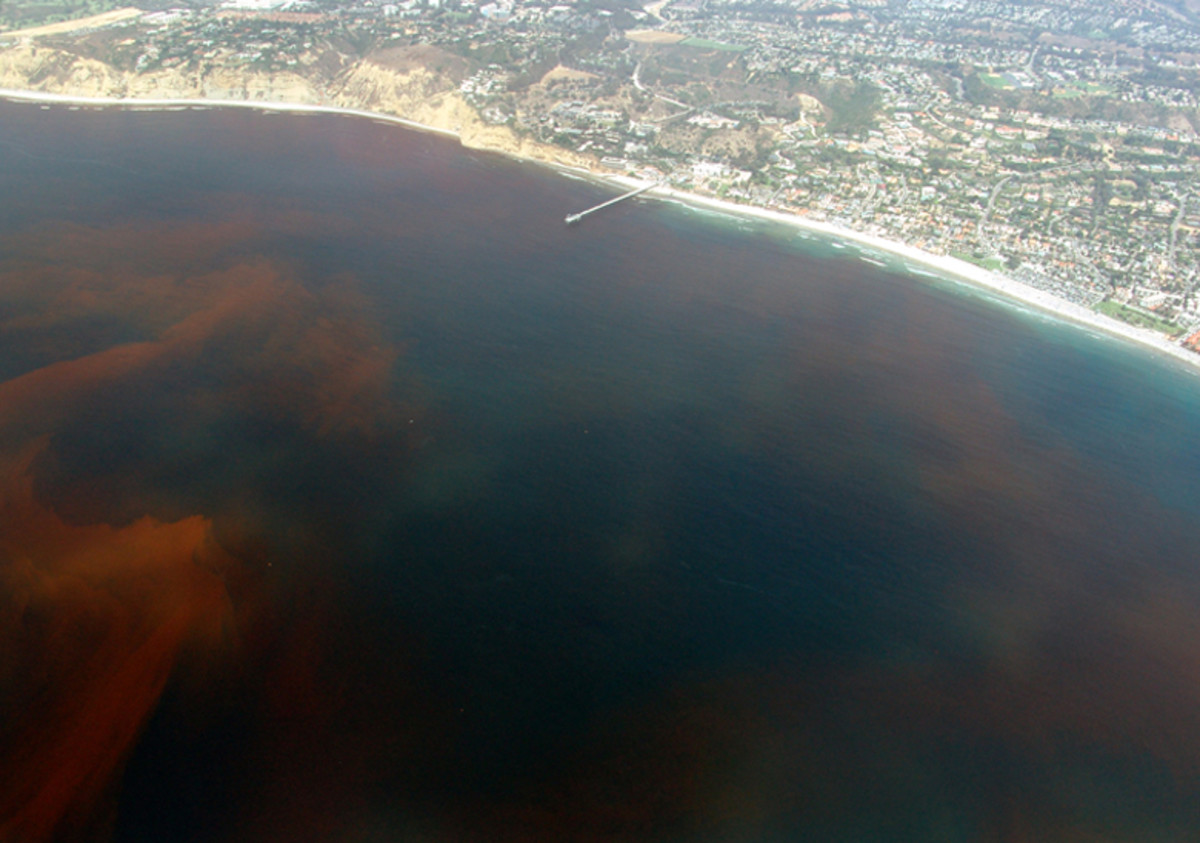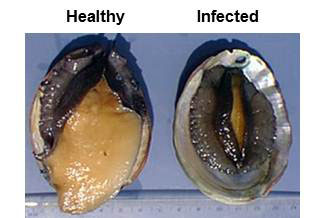White Abalone - Peter Bronge
White Abalone
Haliotis Sorenseni
 |
| Algal bloom along California coast |
 |
| Abalone "foot" |
Description & Ecology
The White Abalone is a large sea mollusk native to the California coast and is a member of the Haliotidae family. Their most notable physical characteristic is their large, convex shell that homes the organism and protects it from predators. These humongous sea snails make a living by gripping onto rocky surfaces with their large foot-like muscle and then feeding off of the algae that surrounds them. Abalone play an important role in the marine ecosystem by keeping levels of algae at bay - areas where abalone populations have declined are shown to suffer from very high populations of algae. These algal blooms cause oceanic dead zones, virtually killing or driving away any life that was currently there. Incidences of harmful algal blooms have increased along the California coast since all types of abalone have been run to bare minimum.
 |
| Native American Abalone Bead Necklace |
Geographic & Population Changes
For Centuries, coastal Native American tribes such as the Miwok tribe had utilized abalone not just to eat but for use of its shell in things like jewelry, fish hooks, tools and weaponry. Although many tribes found many practical uses for the animal, fishing for abalone was difficult. Skilled tribesmen could dive deep down along the ocean floor and collect abalone in small quantities. Regarding the abalone as an ocean jewel, the native tribes took special care to to sustain the amount of abalone that were in the wild.Within the last hundred years, however, commercial fishing and private entrepreneurship have has driven abalone numbers down in staggering decline. Abalone have a very slow and infrequent reproduction process and over fishing has caused their numbers to dwindle down severely. Due to its beautiful shell and sought-after taste, white abalone have been harvested from the wild in excess, ranking it the fastest-declining species of abalone among all other type.
Type of Listing
Endangered.
Main Threats
 |
| Healthy Abalone vs. Abalone Infected with Withering Syndrome |
- Over fishing
- Infrequent Reproduction
- Disease
Commercial farming of abalone coupled with their slow and infrequent reproduction cycles has caused all species of California abalone to decline over the years. In addition to these factors, abalone are also susceptible to infectious viral diseases, the most harmful being a sickness called withering syndrome which shrinks the size of the abalone foot, causing the entire organism to weaken and making it less viable for life.
Recovery Plan
| White Abalone Coastal Habitat Region |
Efforts have been made to reduce the amount of abalone that can be harvested from California shores in hopes of restoring parts of the abalone communities that once thrived. Some businesses have tried to start abalone farms in which abalone are raised in captivity, however most have deemed to be unsuccessful as abalone live prosperously only under conditions that are found in the wild. The NOAA, or National Oceanic & Atmospheric Administration, has made efforts to fund protected oceanic zones, instill habitat protection through regulations, crack down on poachers and illegal trade and educate people in efforts to stabilize abalone communities along the California coast.
What Can You Do?
The best thing anyone can do is to get educated. Know the facts, know the causes. The decline of abalone is not insignificant. Abalone play a key role in maintaining California's homeostatic conditions by keeping algae levels at minimum. Since the decline of abalone along California, harmful algal blooms have become more and more frequent, causing all forms of life to vacate or die in their toxic wake. Even partial restoration of the abalone community would have dramatic effects. For centuries, abalone have been used and enjoyed for their taste, elegance and beauty - let us act now to preserve this wonderful creature.
Sources:
https://www.wildlife.ca.gov/Conservation/Laboratories/Shellfish-Health/Abalone-Diseases
http://www.westcoast.fisheries.noaa.gov/protected_species/abalone/abalone.html
http://www.nmfs.noaa.gov/pr/recovery/plans.htm
http://www.nmfs.noaa.gov/pr/species/invertebrates/abalone/white-abalone.html



Great photos, they are super helpful to picture what abalone look like and how beautiful the shell is. Its interesting how they're relatively small and understated but can have a huge impact on other marine life and the oceans ecosystem.
ReplyDelete-Maeve Calanog
No idea that the white abalone was the fastest dealing population of all abalone species. I didn't even know there was more than one abalone species. It's really sad that they are being overfished when they have such dwindling populations and are such a staple to marine ecosystems :(
ReplyDelete-Maddie Brogno
It's so sad to hear of the decline of these mollusks. They are so important for the ecosystem and without them the algae blooms will just increase, causing more dead zones. And you would think people here in California would do more to help since it is affecting our own coast! Overall, great post and pictures! The picture of the diseased abalone next to the healthy one was really interesting to see and I think it really showed how the disease affects them. - Amber Buzzard
ReplyDeleteAwesome job with this post, I really learned a lot about these little creatures! I think it is super important to really instill more habitat protection on our coast because there are thousands of creatures like the white abalone that are in endanger. I wonder what kinds of ways scientist are trying different ways to re-create their habitat in captivity, that would be a game changer. Definitely an interesting topic! - Xavier Caldera
ReplyDeleteGood job on your blog, I like the graphics! I did not know that the decline of the species was due to algal blooms, over fishing and disease. Seems like the issue is similar to the ivory trade in the perspective that we must stop the demand of the abalone for jewelry and other material items. -Christine Bradley
ReplyDeleteWow this is wild. I never knew that there were different types of abalone I always assumed there was one. Really didn't know too much about them until reading this! Sad to see these beautiful creatures declining because of algae blooms. This issue really hits home because it takes place right here off the central coast. I liked the inclusion of the charts and many pictures. Great job! -Tanner Coolidge
ReplyDeleteI originally thought of abalone as a mollusk similar to a clam where it would be able to reproduce frequently and in vast numbers, so I was surprised to learn that abalone have such a slow and infrequent reproduction process. It's so unfortunate that because of overfishing humans are not only harming the white abalone population but the species that depend on it for sustenance as well. Great post, I learned a lot! - Sirena Chu
ReplyDeleteI think it is very interesting how often humans use other organisms, such as the White Abalone, for their personal use. Many times they forget that these organisms have their own lives and are negatively affected by us. We think more about ourselves and what we want and should be more conscious of them.
ReplyDelete-Adrienne Chin
Great structure and organization of the information. I like the graph comparing your particular species to other species of abalone, showing how not just one but all species are showing a decrease in their population size. Great post!
ReplyDelete-Shea Blackman